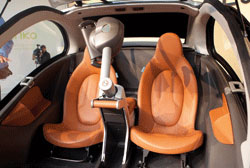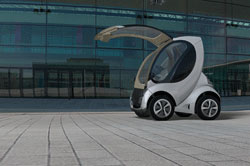
Hiriko: Making Urban Mobility Sustainable
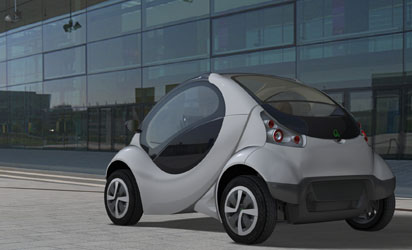
The car is specifically designed for short intra-urban trips.
Studies confirm that 80 percent of car trips in urban areas involve a single person.
(Photo: © Hiriko (Afypaida))
By Catherine Jewell, Communications Division, WIPO
The world’s cities are under pressure. With the urban population set to rise to 4.9 billion by 2030, the race is on to find ways to reduce their ecological footprint. The estimated one billion plus vehicles on the roads means city planners are looking for solutions to the widespread, chronic problems of urban congestion and pollution. The Hiriko Mobility Project, unveiled in Brussels in late January 2012, offers some hope of a way forward. The project is not only delivering the world’s first sustainable urban vehicle, it also seeks to modify the mobility habits of city dwellers and to create opportunities for regional economic development.
Launched at European headquarters in Brussles, the futuristic, pod-like Hiriko was hailed as “a giant step forward in urban mobility” by European Commission President José Manuel Durão Barroso.
Some 10 years in the making, this brainchild of researchers at the Massachusetts Institute of Technology (MIT) Media Lab in the United States has been spun out and developed by a consortium of seven firms in Spain’s Basque region, namely, BRW-Basque Robot Wheels, Forging Products, Guardian, Ingeinnova, Maser Mic, Sapa and TMA. The project is being coordinated with Etud Ibérica, by the Denokinn Center (the Basque Centre for Social Innovation, Entrepreneurship and New Business Development) under the direction of AFYPAIDA, an association dedicated to promoting the Spanish auto industry. The Hiriko, which stands for “urban car” in Basque, is set to go into production in 2013. An estimated 9,000 units will be produced annually by 2015 under different franchises in Europe and the United States.
Compact, Cutting-edge and Clean
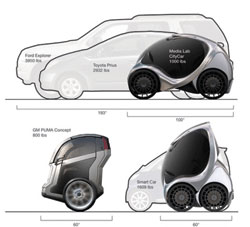
When parked the Hiriko shrinks to a third of the length
of a conventional car, making it possible to fit three of
them into a single parking space.
The Hiriko is designed specifically for short intra-urban trips and to alleviate congestion, parking problems and tailpipe emissions in urban centers. Its radical design, which shifts the drive to the car’s wheels, reduces its parking footprint. When parked it collapses to a third of the length of a conventional car, making it possible to fit three of them into a single parking space. Passengers can easily exit the car from the front using its retractable windshield. The back compartment provides generous storage space and is also easily accessible.
Unlike conventional vehicles, the Hiriko does not have a central engine or traditional power train but is powered by four in-wheel electric motors. “Each wheel unit contains a drive motor (which also enables regenerative braking), steering and suspension and is independently digitally controlled,” the MIT design research team explains. This means the vehicle can spin 360◦ on its own axis, move sideways into parallel parking spaces or change lanes moving sideways.
The Hiriko’s innovative navigational systems include a “haptic” steering mechanism (a tactile feedback technology) that assists drivers and offers the possibility of electronically adjusting driving speeds to city limits. Its revolutionary ergonomics provide for a fully integrated sound system and a touch screen central console with instant access to practical urban information (e.g., nearest parking, best routes) and cultural and entertainment options via mobile phone and the Internet.
The car’s lithium-ion batteries last for around 120 kilometers between charges. Recharging is possible with inexpensive home charging units, and automatic recharging at designated parking spaces is foreseen when the project pilot rolls out in 2013.
| Technical specifications of the Hiriko | |
|---|---|
| Dimensions | 2.63 m (length) x 1.75 m (width) x 1.54 m (height) (fully extended) 2 m (length) x 1.75 m (width) x 2 m (height) (folded) |
| Range | 120 km |
| Power | 15 Kw nominal/20 hp |
| Acceleration | 0 to 70 km/hour in 8 seconds |
| Traction | 4-wheel drive |
| Steering | synchronized 4-wheel steering via a haptic steering wheel |
| Charging time | from 20 percent to 100 percent: fast – 20 minutes; slow – 6 hours |
| Passengers | 2 |
| Weight | 400 kg without batteries |
| Slope capability | up to 20 percent |
| Storage capacity | 300 liters |
| ICT | Integrated sound system, i-phone interface |
The plan is to deploy the Hiriko with cities in car fleets and to lease them to city residents. A number of cities have already expressed interest in acquiring it, including Berlin, Malmö, Barcelona, San Francisco and Hong Kong. Talks are also under way with city authorities in Paris, London, Boston, Dubai and Brussels, according to the Associated Press. The Hiriko delivers an enhanced form of mobility on demand. It offers a new way of moving through cities in symbiosis with other forms of available public transport. The Hiriko will also be available for private sale with an estimated price tag of 12,500 euros excluding tax.
Described as an example of “European social innovation”, the initiative not only provides a viable solution to the major challenges of urban transportation and pollution, it also seeks to create new business and employment opportunities, in particular for the Basque region’s ailing automotive supply sector.
|
|
|
“Plug and Play” Assembly
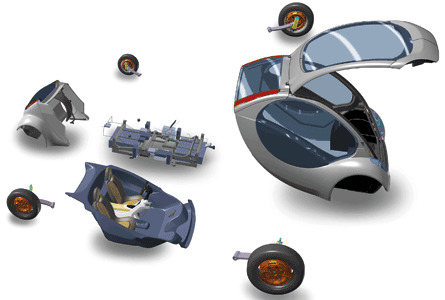
Hiriko is based on an innovative modular system that does note require an assembly
line. Participating companies manufacture their corresponding module – e.g. robot/wheels
(engine and steering included) – which are then assembled in certified distribution centers
across the world. (Photo: © Hiriko (Afypaida))
The project is built around an innovative system of production and distribution that eliminates the need for an assembly line. Each member of the consortium is responsible for manufacturing different components or modules of the car, which are then assembled in a “plug and play” way in certified distribution centers around the world under franchise agreements. All intellectual property rights associated with the Hiriko, including the internationally registered Hiriko trademark, are held by AFYPAIDA.
In addition to assembling the modules, each certified dealership will be responsible for commercializing the vehicle and providing customer care, maintenance and other technical services. Each dealer will become the final manufacturing and assembly agent for the vehicle, thereby creating local employment and economic development opportunities. In this way, participating companies and franchises become co-owners of the Hiriko brand.
At the project’s launch, EC President Barroso said, “Hiriko is an example of how to resuscitate traditional industrial sectors and lead them to new challenges, such as urban mobility.” Hiriko’s Chairman, Jesus Echave, said that the car was a social innovation that would “change cities and their habits” and eliminate the stress and noise of city centers.
The Hiriko not only promises to transform the concept of urban mobility, it has the potential to revive local businesses, boost local employment and to significantly improve the green credentials of cities around the world. It also promises to entice urban travelers to change their travel habits and select more eco-friendly modes of transport.
The WIPO Magazine is intended to help broaden public understanding of intellectual property and of WIPO’s work, and is not an official document of WIPO. The designations employed and the presentation of material throughout this publication do not imply the expression of any opinion whatsoever on the part of WIPO concerning the legal status of any country, territory or area or of its authorities, or concerning the delimitation of its frontiers or boundaries. This publication is not intended to reflect the views of the Member States or the WIPO Secretariat. The mention of specific companies or products of manufacturers does not imply that they are endorsed or recommended by WIPO in preference to others of a similar nature that are not mentioned.
